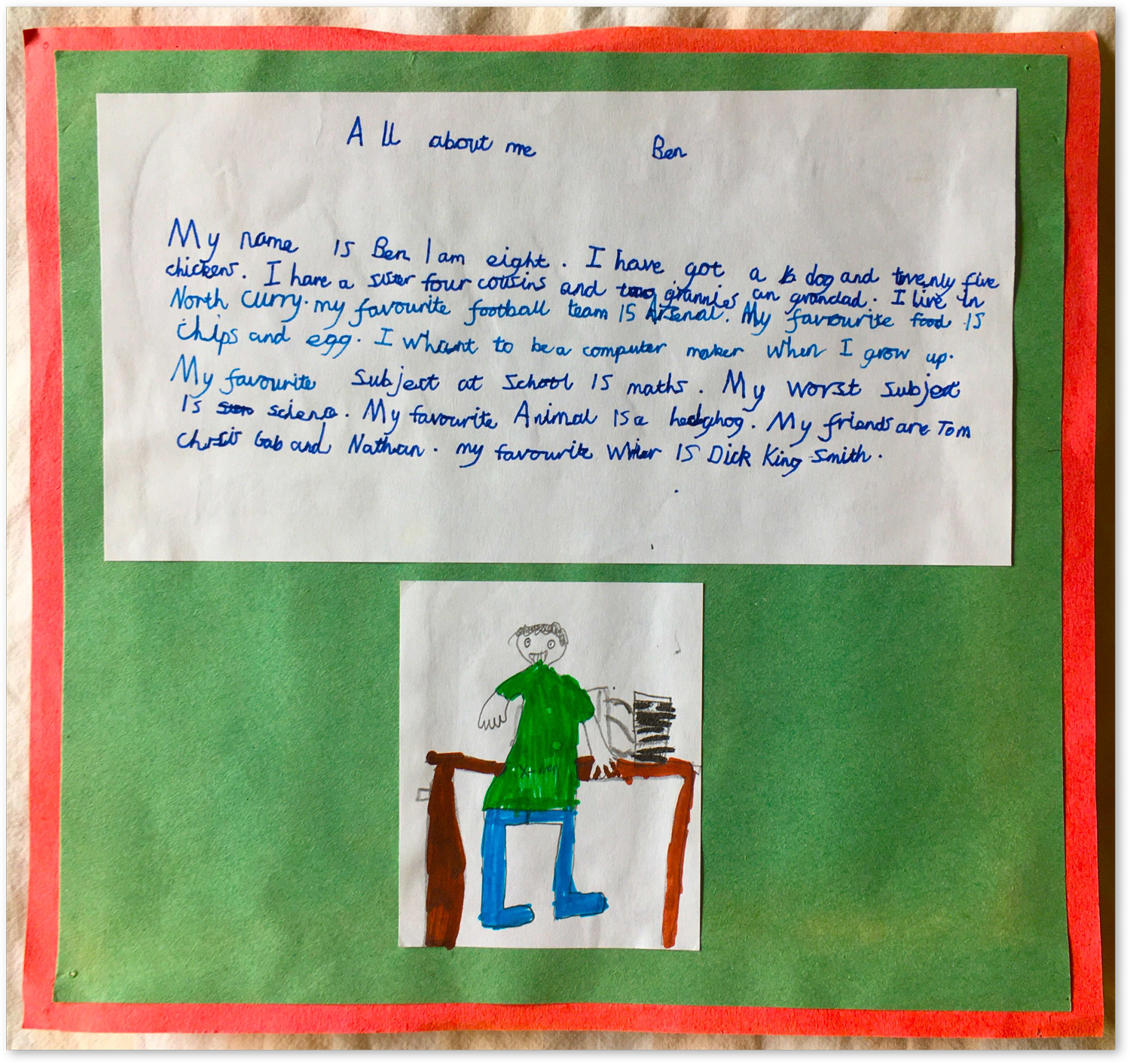Back to Basics
11.05.2023
#coding in situ#bitsphere
#biosphere
#computing
This is a post in a series about Coding in Situ. In this entry, I wanted to explore why my early experience of the internet has led me on this search for a more situated, contextual and intimate way of relating to networked technology. The previous post can be found here.
I feel the need to begin at the beginning. Last year my parents were moving out of the house where they have lived since I was born. I went back there to spend some time going through the various objects and memories that had built up over the past 30 years. Part of this meant going through my bedroom wardrobes and sorting through the school reports, swimming certificates, festival wristbands, teenage payslips and anything else I thought worthy of saving and storing. Whilst going through some of the earlier items from my primary school years, I came across a biography and self-portrait I had made of myself when I was eight years old. In the drawing, I state who I am, where I live, how many chickens live in the garden, and my favourite football amongst other things. About halfway through I lay down my childhood intentions: "I want to be a computer maker when I grow up". The portrait drawn below the biography is a full-body portrait of me hovering about 20cm off the ground in front of a table with what I assume is a computer on it.

When I explain to people where I grew up, I start by naming the nearest city, Bristol. Then if they know this I give the name of my nearest town, Taunton. At this point, I've lost the majority, but if I do continue I name the nearest village, North Curry. The village of North Curry has around 1500 inhabitants, but I didn't live in the village. I lived down a small, narrow road ironically named Broad Lane. There were about five other houses in this small hamlet on Broad Lane and it is here that I spent the formative years of my life.
I grew up quite disconnected from the activities and culture that went on in more populated urban areas, instead, I was very connected to the land, the human and more-than-human inhabitants, and the cycles of weather, seasons, and agriculture that affected them. I don't remember exactly when my parents got a computer, but I remember the feeling of being incredibly captivated by it. At first, I played games and drew using MS Paint, and then when an internet connection arrived at our house, I went online. I used the internet to download music, build websites with my friends about our bikes and explore a world out there that I didn't have access to in Broad Lane.
I think somehow this combination of connection online and disconnection in physical space has informed the way I use technology today and the certain types of technology that I am seeking. Last year whilst reading an essay by Alice Yuan Zhang called The Myth of Web3 I came across a quote from Ursula M. Franklin in her lecture The Real World of Technology:
“The struggle to understand and steer the interaction between the bitsphere and the biosphere is the struggle for community in the broadest ecological context.”
The Bitsphere and the Biosphere, the virtual and the material, the digital and the analogue. A lot of my work over the last few years has been somewhat in searching for the spaces, moments and events that these two 'opposites' become less oppositional and more relational. When searching for Coding in Situ, I believe that the type of 'coding' that I am searching for begins to blur, melt and dissolve the boundaries between the bitsphere and the biosphere so to see not only how one may influence the other but how they are intertwined (intertwingled) deeply with one another on so many levels.
When I grew up in the countryside, I spent time looking into a window attached to a computer that gave me access to a whole other world than the one I could see from the window attached to my house. However, growing up with both windows side by side and seeing how lightning, rain and wind out of one window affected the connection speed (or connection full stop) of the other window made me consider the ways in which these two separate windows might not be so separate at all.
From an early age, I became interested in how computers work, but mainly how they talk and how I can talk with them and become social, discover ways of doing things beyond the realm of what I knew possible and then add my realm into the mess of what at that time was the web. Today, Coding in Situ is my attempt to find methods, practices, technology and people that are making the edges of computing seem soft and blurry. It's a guide and a practice for how to relate differently.
Simultaneously, it's a way of looking back, not for a flicker of nostalgia at how things used to be, but to see where potential once lay and to begin to imagine new ways of computing today. It's an attempt to uncover what could have been instead of accepting what now is. In my next entry, I will go a little bit deeper into these other ways of computing could have been.
Back…